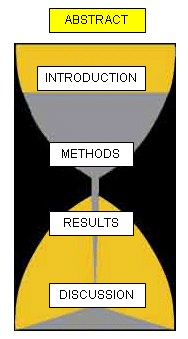|
MAIN SECTIONS
It is difficult to make generalizations about how academic research articles and reports should be organized. The norms vary greatly from one field to another. However, the organization is traditionally represented by the image of an hourglass (tiimalasi). You know the shape: wide at top, narrowing towards the middle to allow only a few grains of sand to fall through at a time, and finally widening out again to hold the built up layers of sand.

The hourglass conceptualizes the traditional sections of a paper: the Introduction, Methods, Results and Discussion sections, often referred to by the acronym IMRaD.
- The Introduction Section should convince readers of the relevance of the study. It identifies a problem in the real world and narrows down the scope of the research into a specific research question that the study attempts to answer.
- The Methods Section traditionally outlines how this research was conducted. With the scope of the research restricted to a manageable focus, the study can be represented by the neck of the hourglass.
- The Results Section describes the outcome of the research and, together with the Methods Section, comprises the main body of the research.
- The Discussion Section broadens the focus again, relates the study back to the outside world and presents the impact and wider implications of the research.
Independent of the hourglass, the abstract provides a summary of the article or report.
|
